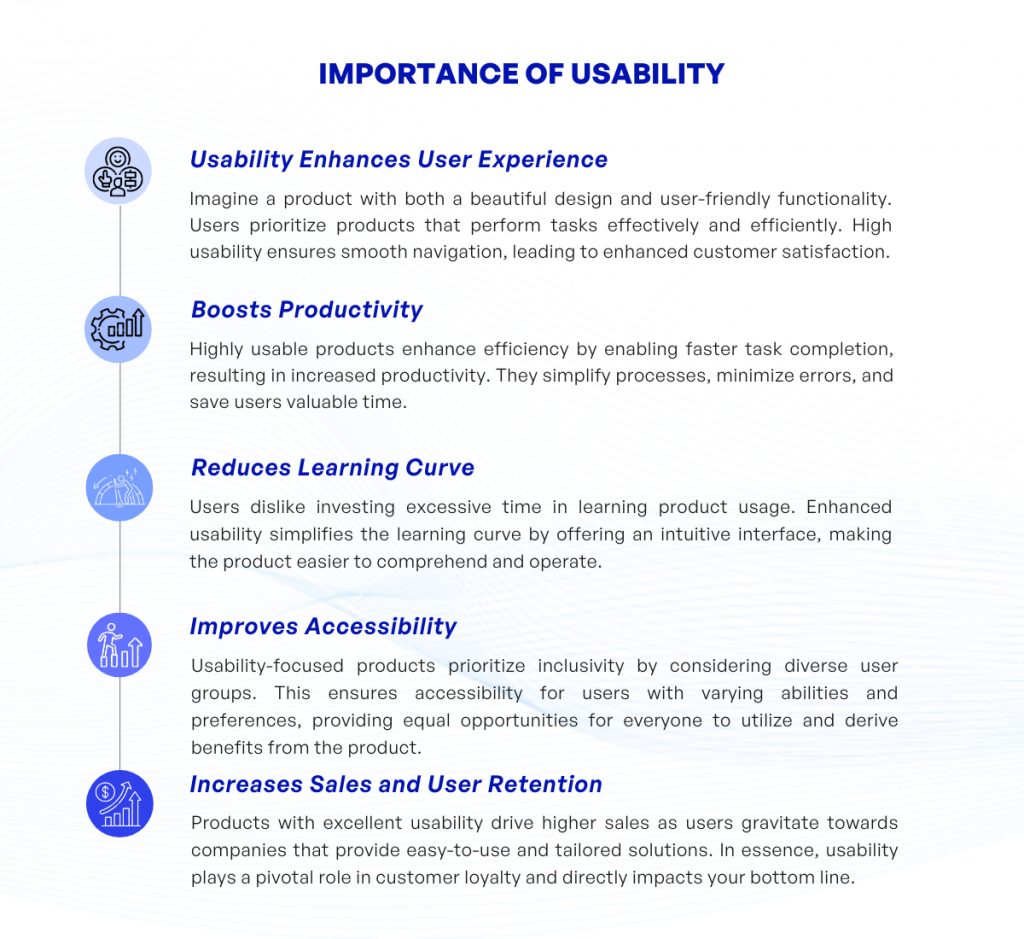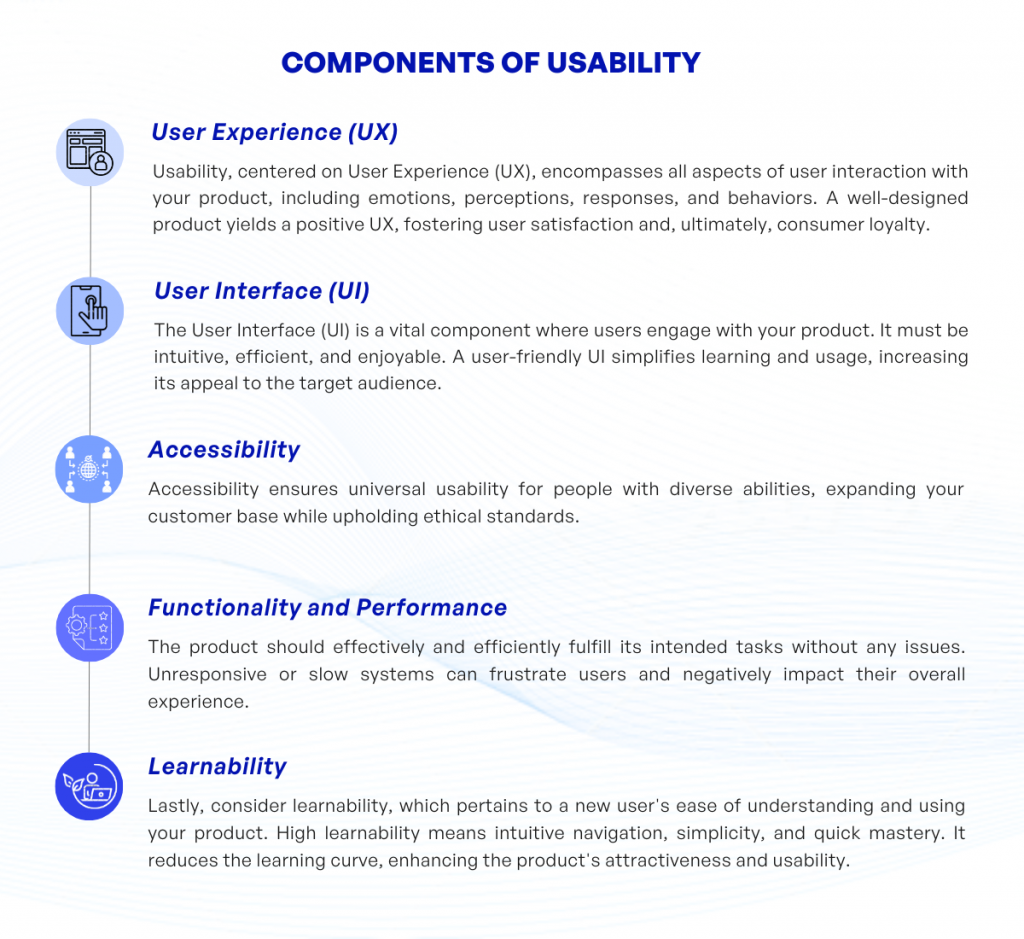
Did you know that 70% of online businesses fail due to bad usability? This simple yet shocking statistic highlights the critical role usability plays in product development.
Usability rules the Web. Simply stated, if the user can’t find a product, then he or she will not buy it.
As you dive into this article, you’ll begin to understand the major components of usability, the benefits it brings to product development, and the common practices best-performing companies use to integrate usability into their product development processes. So, do you want to be among the 30% that succeed? Strap in as we unravel the fascinating world of usability.
1. Discussing Usability: An Essential Aspect for Product Success
Ever wondered what makes some products a joy to use, while others leave you frustrated and confused? The difference often lies in the concept of usability. As its name implies, usability refers to the ease of use of a product, system, or interface. But its implications extend much further than just user satisfaction. By directly shaping the overall user experience, the usability of a product can significantly affect its success or failure in the market. A product that’s easy to use offers a clear value proposition, and meets the needs of its users is more likely to be adopted and recommended, boosting engagement, retention, and ultimately, profitability.
Product development, as you may know, is a complex process of ideation, design, development, testing, and launch. But how does usability fit into this process, and why is it a crucial part of product development? That’s what this article is here to answer, offering a deep dive into the concept of usability and its role in product engineering.
Stay with us as we explore the importance of usability, its core components, testing methods, and some of the challenges encountered in its implementation. Whether you’re a seasoned product developer, a business owner, or simply an inquisitive mind, our aim is to enhance your understanding of usability and its transformative impact on product development.
2. Importance of Usability

You might wonder, ‘Why is usability such a critical factor in product development?’ The answer lies in understanding what usability can contribute to the overall success of your product. The importance of usability cannot be underscored enough. It is a key metric that hugely influences the overall customer experience.
2.1. Usability Enhances User Experience
Imagine a product with an aesthetically pleasing design but complicated functionality. End-users would rather choose a product that performs tasks adequately and timely, wouldn’t they? Products with high usability cater to the user’s intent, making the user navigation journey smooth and enjoyable. Thus, enhancing customer satisfaction.
2.2. Increases Productivity
Highly usable products result in increased efficiency. They allow users to accomplish tasks faster, boosting overall productivity. They eliminate unnecessary complexities and reduce the likelihood of errors, saving valuable time for users.
2.3. Reduces Learning Curve
No user likes spending excessive time learning how to use a product. Usability in a product simplifies the learning process. The more intuitive the interface, the easier the product is to understand and use.
2.4. Improves Accessibility
Products with good usability are developed keeping diverse user groups in mind, promoting inclusivity. It makes sure products are accessible to users with different abilities and preferences, ensuring that everyone has an equal opportunity to use and benefit from your product.
2.5. Increases Sales and User Retention
Products with superior usability typically see more sales. Users tend to stick around with the companies that offer products that are easy to use and meet their needs. In other words, usability can make or break customer loyalty and impact your bottom line.
By focusing on usability during product development, you can build a product that not only meets the functional requirements but also excels in terms of user satisfaction and experience. Simply put, usability is the bridge that connects product innovation to commercial success.
3. Components of Usability in Product Development

When we talk about usability in product development, we are actually referring to a complex network of factors. So, what exactly are the components of usability in product development? Let’s delve deeper into this subject.
3.1 User Experience (UX)
First and foremost, usability revolves around the concept of User Experience, often referred to as UX. This includes everything the user encounters while interacting with your product – their feelings, perceptions, responses, and behaviors. An optimally designed product results in a positive UX, leading to user satisfaction and in turn, consumer loyalty.
3.2 User Interface (UI)
The User Interface, or UI, is another crucial component. This is the point where the user interacts with your product. It should be, without exception, intuitive, efficient, and enjoyable. This facilitates easier learning and handling of the product, making it user-friendly and thus, more appealing to your target audience.
3.3 Accessibility
Accessibility refers to how easily a product can be used by people with varying abilities. In essence, your product should be universally usable, regardless of a user’s physical condition or environmental situation. By ensuring accessibility, you’re not just adhering to ethical practices, but also broadening your potential customer base.
3.4 Functionality and Performance
The functionality and performance of a product also play a significant role in its usability. The product must perform the tasks it was designed for, without fail, and do so quickly and efficiently. Unresponsive or slow-processing systems can lead to user frustration, adversely affecting their overall experience.
3.5 Learnability
Lastly, let’s talk about learnability. This term refers to how easily a new user can understand and use your product. A product with high learnability is easy to navigate through, simple to understand, and quick to master. It reduces the learning curve for the user, thus making the product more attractive and usable.
In essence, all these components work together to create a usable product. Where one falls short, others must compensate to ensure a balanced, enjoyable, and accessible user experience. Now, wouldn’t you agree that usability in product development is indeed a multilayered concept?
4. Usability Test Methods
As we delve deeper into the world of usability, it’s important to discuss the testing methods employed during product development. Why, you may ask? Understanding these testing methods can enable you to ensure that your product will function as intended and meet your users’ needs. So, what are some of these methods?
User Testing
One of the most common usability testing methods is user testing. User testing is a method where representative users perform tasks using the product while those responsible for its development observe them. The feedback gained from these sessions can allow developers to identify any difficulties users may face, and subsequently make the necessary changes to improve usability.
Expert Reviews
Another popular approach in usability testing is expert reviews. These are reviews conducted by usability experts who evaluate the product based on their knowledge and experience. They assess the product’s consistency, discoverability, user control, and more. They provide objective evaluations based on established usability principles, although it’s key to note, that they cannot always predict the users’ actual interactions with the product.
Automated Usability Testing
In recent times, automated usability testing has gained much traction. This method makes use of technology to gather user interactions and analyze them for patterns that may suggest usability issues. This method can be applied in large-scale user testing and is often efficient, although it lacks the personal touch and insight that can be gained from
direct user observations.
Card Sorting
Card sorting is a unique method where users are given a set of concepts on cards and asked to categorize them. This technique is useful when designing or evaluating the navigation and structure of a product. It highlights how users perceive and expect the information to be organized, which can greatly influence the product’s usability.
A/B Testing
Lastly, A/B Testing is another useful method in the usability testing toolbox. Different users are presented with two variants of the same product (Version A and Version B), and their interactions and preferences are monitored. This testing method is quite effective in identifying which design or feature is more appreciated and usable by target users.
Undeniably, these are just a handful of the multiple ways you can go about testing usability. Remember, choosing the right technique will depend on factors like the nature and stage of your product, the resources available, and the information you aim to extract. A solid usability testing plan often employs a combination of the methods mentioned above.
5. Challenges of Usability in Product Development
Embracing usability in product development isn’t always a walk in the park. There are distinct challenges that come with it, often leading to compromises and adjustments. But don’t let this dampen your enthusiasm. Each challenge offers an opportunity for growth and learning. So, what obstacles are you likely to encounter?
Limited Understanding of User Behavior
Most product developers are experts in their field, but not necessarily in understanding user behavior. Getting into the minds of the users, and understanding their needs, challenges, and expectations can be a tough task. Furthermore, users’ behaviors evolve over time, making it a moving target.
Reconciling User Needs and Business Goals
Another challenging aspect is finding a balance between what’s technologically feasible, what users need, and business goals. Sometimes, these aspects may not align, and tough decisions have to be made. This could involve painstaking compromises that could affect the product’s overall usability.
Design Constraints
Constraints such as budget, timeline, and technology can significantly hinder usability in product development. These constraints may put pressure on the development team, leading to oversights in usability considerations. This can result in a product that does not truly meet user expectations.
Inadequate Usability Testing
Usability testing is critical, but it can also be time-consuming and expensive. It can be tempting to cut corners or rush through this process, but this can lead to serious usability issues later on. The challenge is to conduct thorough and effective testing within the
project’s constraints.
Incorporating Feedback
A significant challenge in usability is translating feedback into actionable improvements. Users might have conflicting opinions or may not articulate their feedback in a way that leads to clear actions. This requires careful analysis and insightful interpretation.
These challenges, albeit daunting at times, push your product development skills forward. Remember, every challenge you overcome puts you one step closer to creating a product that is not only usable but enjoyable for your users. Fostering a user-focused mindset is essential in delivering cutting-edge products in today’s competitive market.
6. Conclusion
In conclusion, usability plays an essential role in product development, shaping the customer experience, determining long-term product success, and impacting the bottom line of businesses. When you integrate usability into your product development process, you allow your product to speak your users’ language, facilitating a seamless interaction and an increased level of satisfaction. Remember, usability isn’t just about User Interface (UI), it encompasses User Experience (UX), Accessibility, Functionality, Performance, and Learnability.
Moreover, usability testing methods, despite the challenges they present, offer invaluable insights that can help improve your product. They give you a clear picture, a real-life instance of how your product is actually being used by the users rather than how you assume they’d be using it.
Overcoming the challenges of usability in product development is indeed not a cakewalk. Reconciling the imperatives of business and user needs, understanding user behavior, grappling with design constraints, ensuring comprehensive usability testing, and effectively incorporating feedback are but a few of the hurdles one may encounter.
However, the rewards of a successful integration of usability in your product development strategy far outweigh the challenges. So, as you proceed along this path, keep your users at the heart of your decisions, view obstacles as opportunities for growth, and stay open to continuous learning. You’re on a journey to creating products that not only perform
well but also resonate with your users.
If you have any questions regarding usability in product development, feel free to contact KVY TECH.


